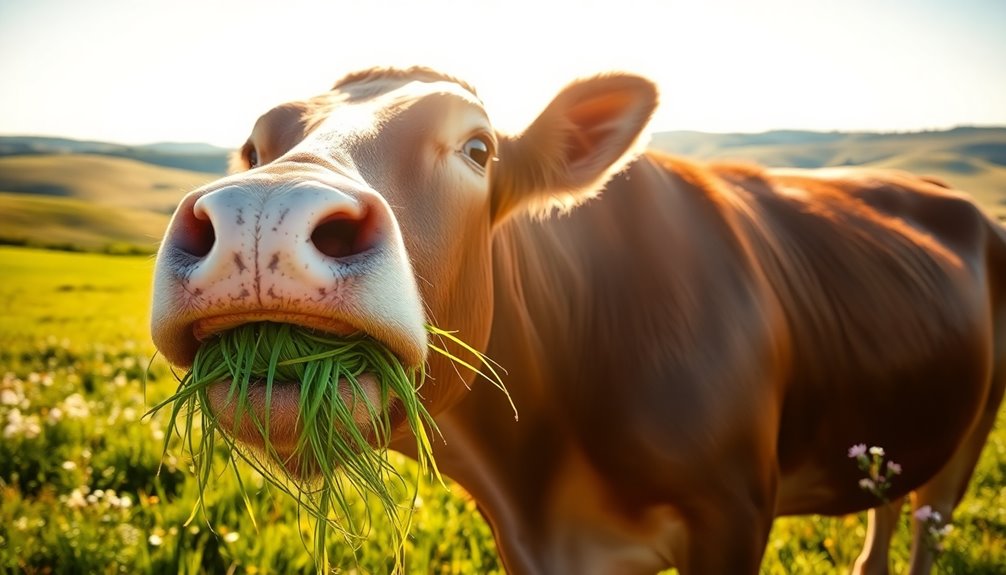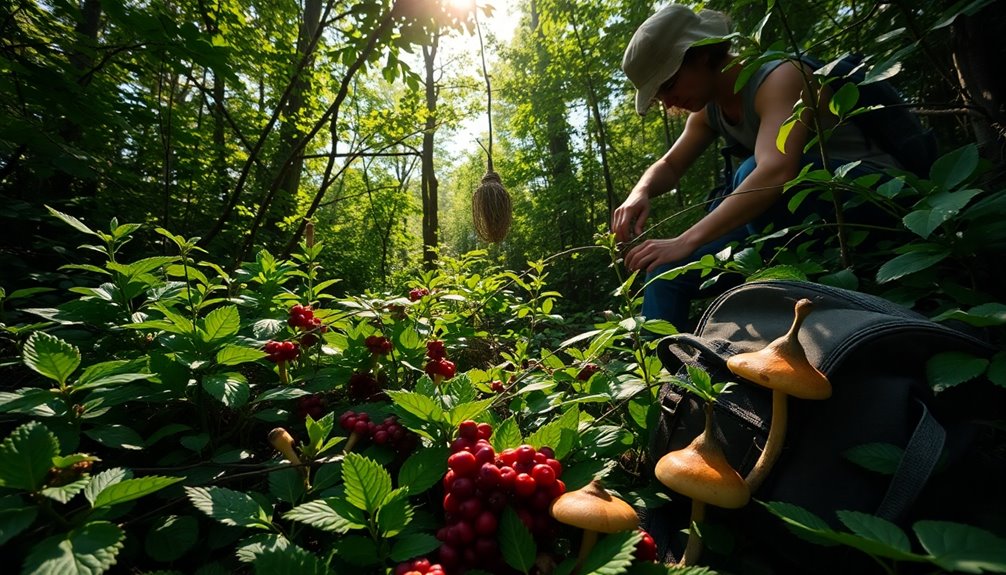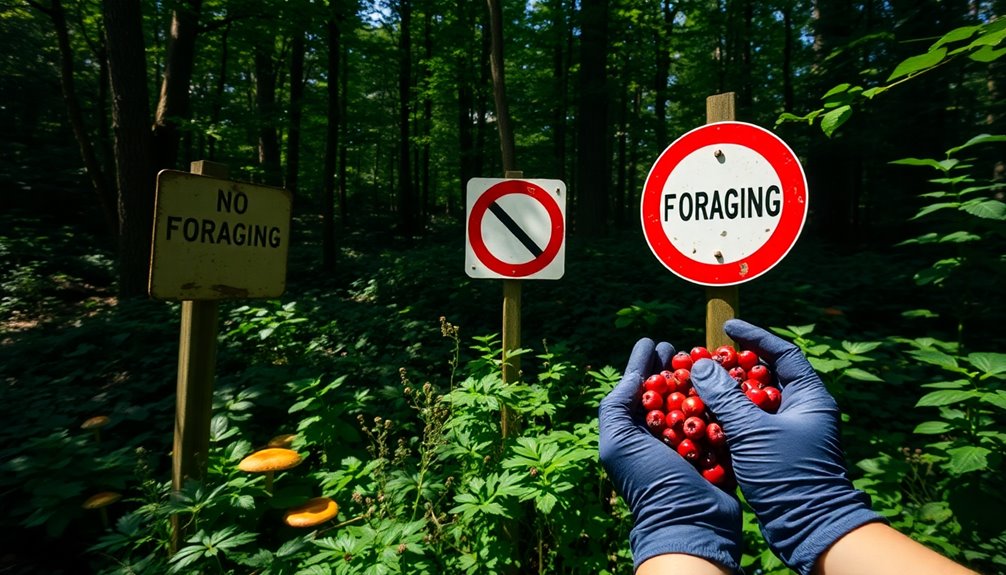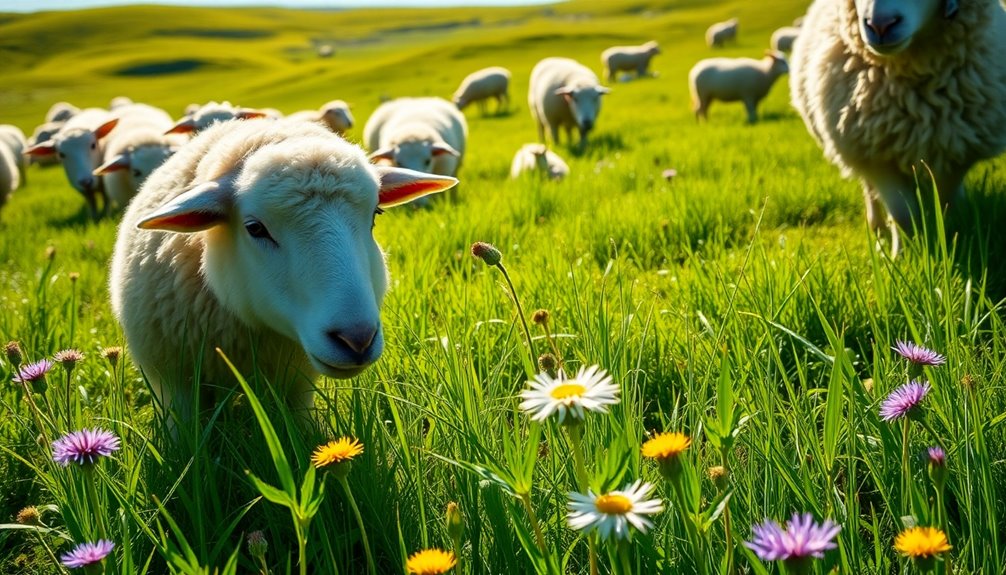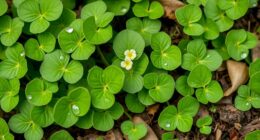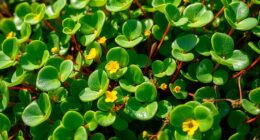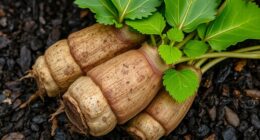Cows can eat an eye-popping 2.5% to 2.7% of their body weight in forage daily, especially if they're lactating and on high-quality pastures. For a 1,200-pound cow, that means consuming around 30 pounds or more of forage each day! Factors like the cow's size, the forage quality, and whether they're pregnant or lactating all impact their intake. Higher-quality forage lets cows consume more, boosting their health and productivity. Want to uncover more fascinating facts about cow nutrition and feeding practices? There's plenty more to explore about how to optimize your herd's forage intake!
Key Takeaways
- A lactating cow weighing 1,200 lbs can consume up to 36 lbs of quality forage daily.
- Dry matter intake (DMI) typically ranges from 1.8% to 2.7% of a cow's body weight.
- High-quality forage (≥8% crude protein) allows for greater intake compared to low-quality forage (<6% crude protein).
- Seasonal changes can significantly impact daily forage consumption and availability.
- Larger cows require more forage, directly correlating their size with consumption levels.
Understanding Dry Matter Intake
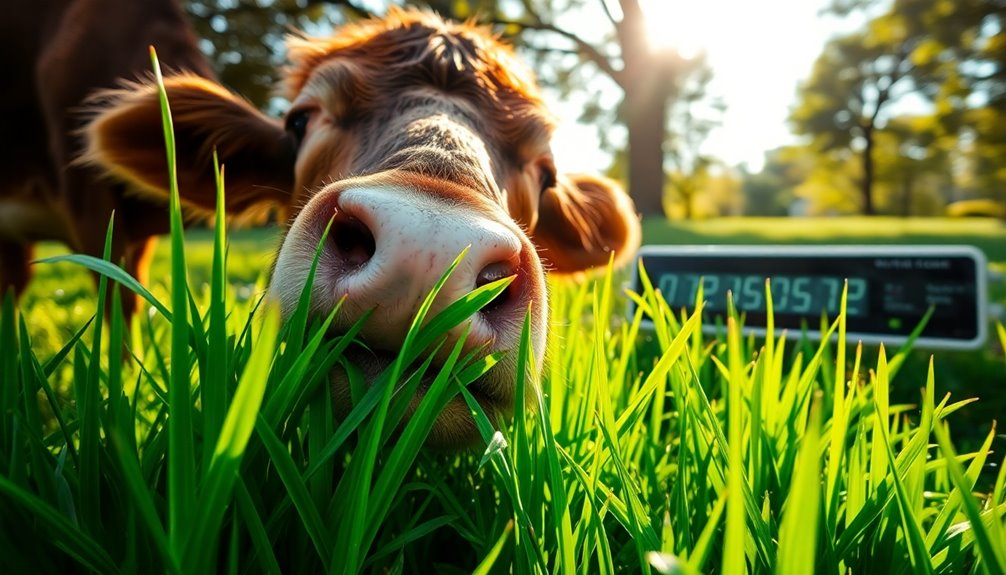
When it comes to managing your cattle's nutrition, understanding dry matter intake (DMI) is key. DMI refers to the amount of feed consumed after excluding moisture content, which is essential for accurate nutritional assessments.
For instance, a 1,200 lb cow that eats 24 lb of hay at 88% dry matter actually consumes about 27 lb on an as-fed basis due to moisture.
Factors like forage quality, cow weight, and lactation status greatly impact daily DMI. Lactating cows generally consume more than non-lactating cows to meet their nutrient needs, often reaching 2.5%-2.7% of their body weight when eating high-quality forages like corn silage.
Monitoring DMI helps you manage forage inventory effectively, particularly during periods of scarcity like calving, ensuring you minimize hay wastage and optimize feeding strategies.
Factors Influencing Forage Consumption
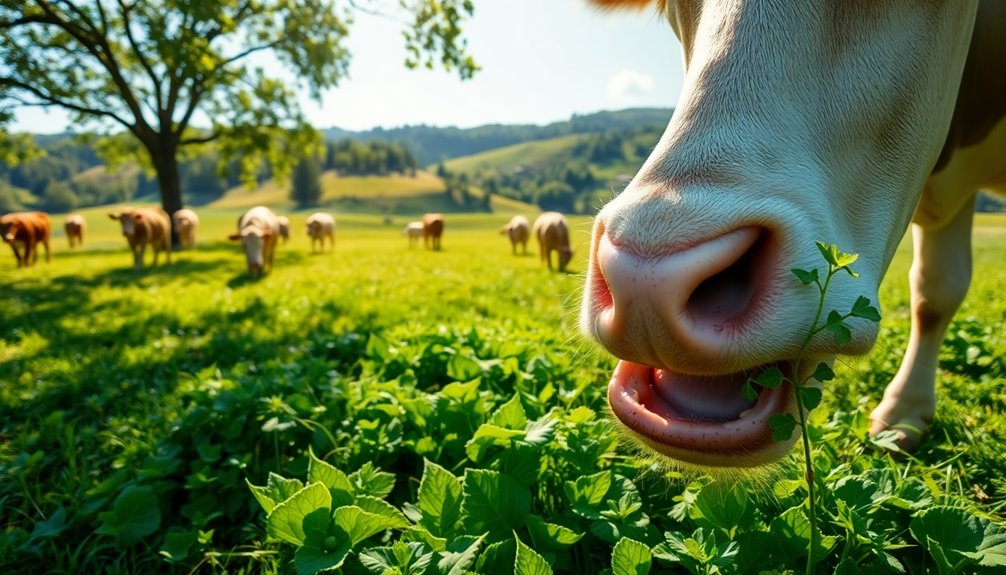
Forage consumption in cows is influenced by several critical factors, including forage quality, cow condition, and environmental conditions. Understanding these influences can help you enhance your cows' forage intake and overall health.
- Forage Quality: High-quality forage can increase daily intake considerably.
- Body Weight: A cow's size impacts its overall consumption; larger cows eat more.
- Nutrient Content: The Total Digestible Nutrients (TDN) in forage determines how much energy and nutrients a cow receives.
- Seasonal Variations: Changes in pasture availability can affect feeding needs.
For instance, a 1,200 lb lactating cow can consume about 28 lb of high-quality forage daily, especially when it contains around 55% TDN. In contrast, if you're feeding low-quality forages (≤52% TDN), expect a consumption rate of about 1.8% of body weight for non-lactating cows.
Additionally, lactating cows require about 50% more TDN than dry cows, demanding increased forage intake during their lactation period. By factoring in these elements, you can guarantee your cows receive ideal nutrition to maximize their productivity and health.
Quality of Forage Matters
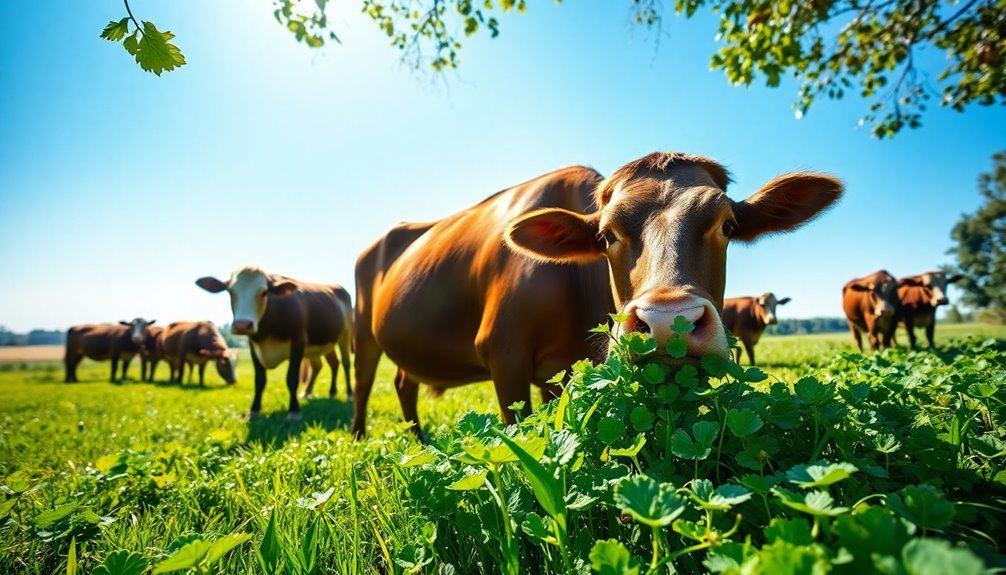
Quality of forage plays an essential role in determining how much cattle consume and their overall health. It's fascinating how the nutrient content can impact a cow's intake. For instance, when you provide low-quality forage with less than 6% crude protein, your cow may only consume around 1.5% of its body weight daily. In contrast, higher-quality forage containing at least 8% crude protein allows for approximately 2% body weight intake.
Here's a quick look at how different forage qualities can affect intake:
| Forage Quality | Crude Protein (%) | Daily Intake (Pounds) |
|---|---|---|
| Low Quality | < 6% | ~18 lbs (1.5% BW) |
| Good Quality | 8% | ~24 lbs (2% BW) |
| Excellent Quality | ≥ 8% | ~30 lbs (2.5% BW) |
| High Digestibility | 55% TDN | ~28 lbs (Lactating) |
| Mature Forage | Varies | Reduced Intake |
The digestibility of these forages is significant. Better digestibility means your cow can absorb more nutrients, leading to improved health and productivity. Prioritizing quality forage is essential for maximizing your cow's potential.
Estimating Daily Feed Requirements
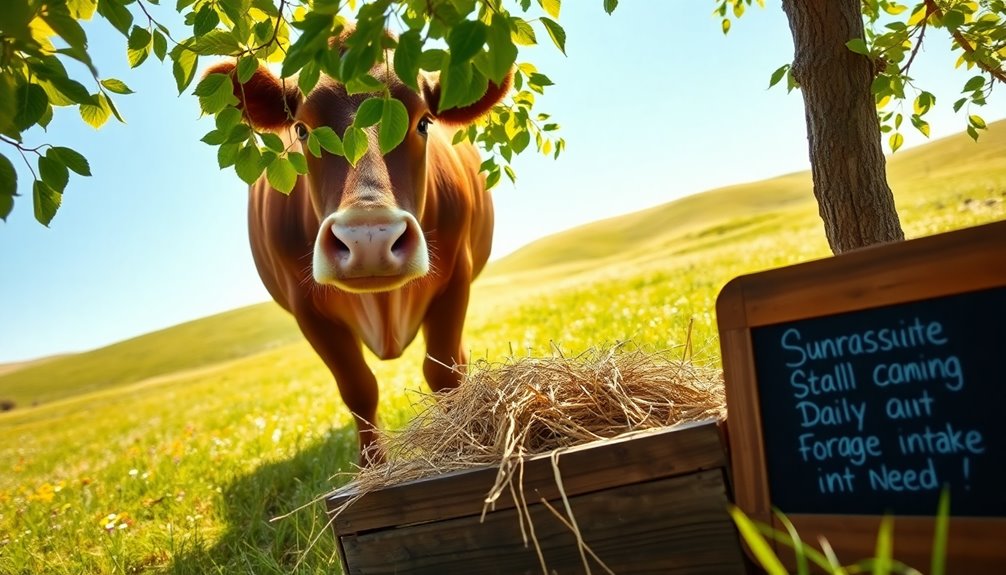
Understanding how much feed your cows need is essential for maintaining their health and productivity, especially after exploring how forage quality impacts their intake. When estimating daily feed requirements, you must consider factors like body weight, moisture content, and nutrient needs.
- A 1,200 lb pregnant cow typically consumes about 24 lbs of good-quality grass hay daily, factoring in a 15% hay wastage rate, which brings it to around 30 lbs.
- Lactating cows need more, consuming up to 36 lbs of as-fed hay daily to meet their heightened energy and nutrient needs.
- Dry matter intake for non-lactating cows is about 1.8% to 2.1% of their body weight, while lactating cows can reach 2.5% to 2.7%.
- Accurate estimates of daily feed intake help manage your forage inventory, especially during scarce periods.
Seasonal Feeding Strategies
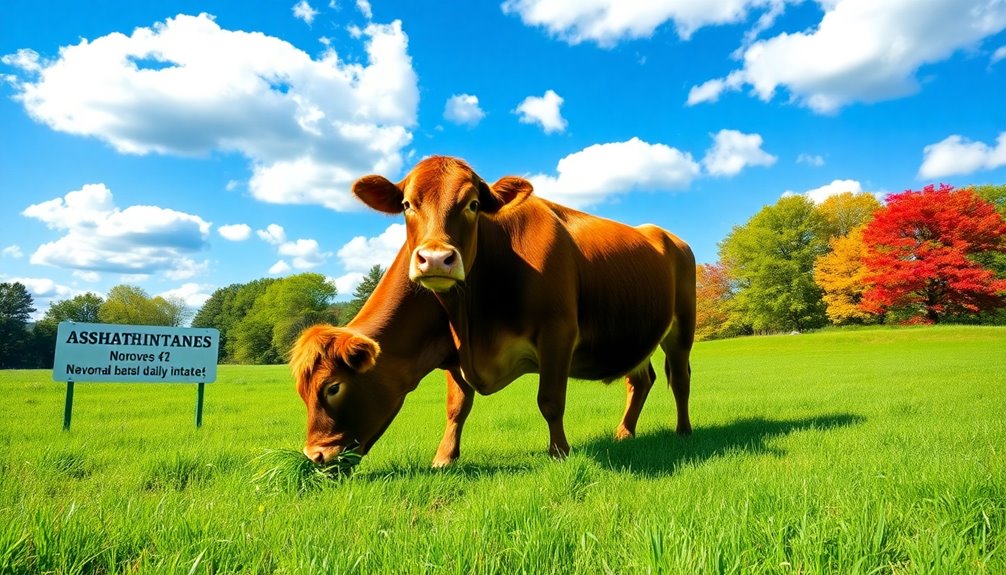
Adapting your feeding strategies throughout the seasons is vital for maintaining ideal cow health and productivity. Seasonal variations in forage availability can drastically affect your hay feeding needs, especially during fall and winter months when standing forage may be limited.
In the fall, utilizing native and Bermudagrass pastures can help reduce reliance on hay, allowing you to make the most of your available forage resources.
As winter sets in, you'll likely find pastures covered in snow or ice, making hay feeding more necessary. This is when it's important to accurately estimate your cows' daily intake needs to guarantee they receive the nutrition they require.
Keeping historical records of forage availability can assist you in predicting how long you'll need to feed hay and plan for any potential shortages.
Moreover, implementing supplementation programs during times of lower-quality forage can greatly enhance digestion and nutrient absorption, further supporting cow health and productivity.
Frequently Asked Questions
How Much Forage Does a Cow Eat per Day?
When you consider how much forage a cow eats daily, it really varies based on several factors.
A typical 1,200 lb pregnant cow usually consumes around 24 lbs of good-quality hay, but that can increase if the cow is lactating or if the forage quality is exceptional.
Generally, you can expect a non-lactating cow to eat about 2.0% of its body weight in good-quality forage, adjusting for moisture and wastage.
What Is the Mental Capacity of a Cow?
Cows have a remarkable mental capacity, comparable to that of a human toddler.
You'll find that they can solve problems and remember experiences for years. They recognize faces, both of other cows and humans, showcasing their strong memory.
Plus, they can learn by observing others, which helps them adapt.
Cows also experience emotions like joy and stress, affecting their well-being, and they communicate through vocalizations and body language to convey their feelings.
How Much Hay Will a 1200 Pound Cow Eat?
Imagine your 1,200-pound cow as a voracious bookworm, devouring pages of hay daily.
She'll munch through about 24 pounds of good-quality hay, about 2% of her body weight.
But wait! If the hay's moisture content is considered, that number jumps to around 26 pounds.
Factor in some wastage, and you'll need to provide about 30 pounds daily to keep her satisfied and healthy.
Adjust her intake as her needs change, especially after calving!
How Much Does a 1000 Lb Cow Eat a Day?
A 1,000 lb cow typically eats about 20 to 24 lbs of dry matter each day, which is roughly 2.0% to 2.4% of its body weight.
If you're feeding hay, that translates to around 25 to 28 lbs on an as-fed basis, depending on moisture content.
Keep in mind that quality matters; high-quality forages can increase intake to about 25 lbs or more.
Be sure to account for hay wastage, too!
Conclusion
To sum up, understanding how much forage a cow eats can really change your perspective on cattle management. Did you know that a single cow can consume up to 2.5% of its body weight in dry matter daily? That's around 30-40 pounds for an average cow! By considering factors like forage quality and seasonal variations, you can optimize your feeding strategies. Keeping these insights in mind can lead to healthier cattle and better yields for your farm.

